Planning Your Backyard Campout
Tips for camping in your backyard – Planning a backyard campout is a fantastic way to enjoy the outdoors without the hassle of a long drive or complicated logistics. It’s a perfect opportunity to unplug, reconnect with nature (even if it’s just your own backyard!), and create some fun family memories. With a little planning, you can have a comfortable and memorable experience.
Ideal Backyard Campsite Location
Choosing the right spot in your backyard is key to a comfortable camping experience. Look for a relatively flat area, free from rocks and uneven terrain, to ensure a good night’s sleep. Consider proximity to a power source if you plan on using electronic devices or need to charge things overnight. Ideally, you want a spot that offers some shade during the day to escape the sun’s heat, but also allows for clear views of the night sky for stargazing.
A spot near a water source (hose bib) can also be very convenient for washing up.
Backyard Camping Packing List
A well-organized packing list is crucial for a smooth and enjoyable camping trip, even in your backyard. The list will vary depending on the weather, the length of your stay, and the activities you plan.
- Sleeping Gear: Tent (or sleeping bag on the ground!), sleeping bag, pillow, sleeping pad for comfort.
- Cooking Supplies: Portable stove, fuel, cooking pot, utensils, plates, cups, biodegradable soap, trash bags.
- Lighting: Flashlight, headlamp, or lantern (consider battery-powered options).
- Clothing: Layers are essential for adapting to changing temperatures. Pack shirts, pants, socks, underwear, a jacket or sweater, and rain gear if needed.
- First-Aid Kit: Include bandages, antiseptic wipes, pain relievers, and any personal medications.
- Food and Drinks: Pack easy-to-prepare meals and snacks. Consider non-perishable items to avoid spoilage.
- Bug Spray: Especially important during warmer months.
- Sunscreen: Protect your skin from the sun, even in the shade.
- Entertainment: Books, games, cards, or a portable speaker for music.
Sample One-Night Backyard Camping Schedule
A well-structured schedule ensures you make the most of your backyard camping adventure.
- Afternoon (2:00 PM – 4:00 PM): Set up camp. Pitch your tent, arrange your sleeping gear, and organize your supplies. This is a good time to involve everyone in the family.
- Late Afternoon (4:00 PM – 6:00 PM): Prepare and enjoy dinner. Keep it simple – hot dogs, burgers, or foil packet meals work well.
- Evening (6:00 PM – 8:00 PM): Engage in some outdoor activities. This could be playing games, telling stories around a campfire (if permitted), or simply relaxing and enjoying the peaceful atmosphere.
- Night (8:00 PM – 10:00 PM): Stargazing. Lie back and enjoy the night sky. Bring a star chart or a stargazing app to help identify constellations.
- Night (10:00 PM onwards): Get cozy in your tent and enjoy a good night’s sleep under the stars (or your backyard!).
- Morning (7:00 AM – 9:00 AM): Enjoy breakfast, pack up your camp, and clean up the area.
Setting Up Camp
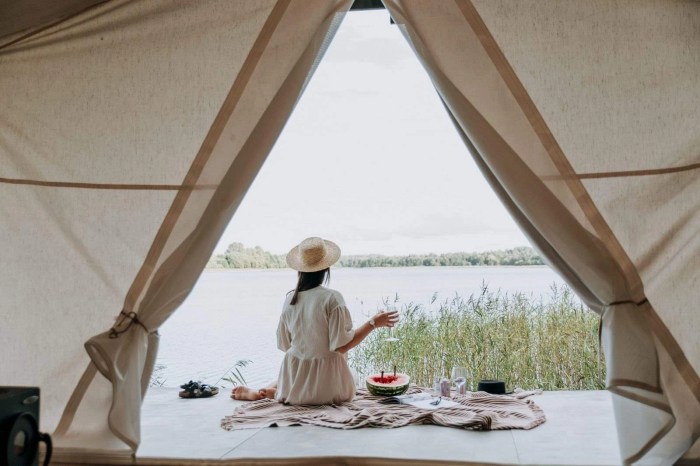
Source: aworldtotravel.com
Setting up your backyard campsite is half the fun! With a little planning and these simple steps, you’ll be ready for a cozy night under the stars (or almost stars, depending on your light pollution!). Remember to always prioritize safety and leave no trace behind.
Tent Setup
Pitching a tent might seem daunting, but it’s easier than you think. First, choose a level spot in your yard, free from rocks and branches. Lay out your tent footprint (if you have one) to protect the tent floor. Then, spread out the tent body and carefully insert the poles according to the manufacturer’s instructions. Most tents use a color-coded system to make this easy.
Once the poles are in place, carefully stake down the corners of the tent, making sure the stakes are driven into the ground at a slight angle away from the tent for maximum hold. Finally, secure the guy lines (the ropes attached to the tent) to stakes or sturdy objects around the tent perimeter. This helps stabilize the tent against wind.
Tighten everything up, and you’re ready to go!
Campfire Construction and Safety
Building a campfire is a quintessential camping experience. If you have a designated fire pit, start by placing kindling (small twigs and dry leaves) in the center, followed by progressively larger pieces of wood. Leave some space between the pieces for airflow. Light the kindling and gently add more wood as it burns. Never leave a campfire unattended, and always keep a bucket of water or sand nearby for emergencies.
When you’re finished, let the fire burn down completely, then thoroughly douse the embers with water until they’re cold to the touch. Spread the ashes evenly and dispose of them properly according to your local regulations.
Alternative Lighting Solutions
If a fire pit isn’t allowed or available, there are many safe and enjoyable alternatives. Battery-powered lanterns provide a bright, consistent light source, and are easily portable. String lights add a festive ambiance, and solar-powered path lights can illuminate walkways safely. Consider the type of lighting that best suits your needs and the atmosphere you want to create.
Sleeping Arrangements
Creating a comfortable sleeping space is crucial for a good night’s sleep. Choose a sleeping bag appropriate for the expected temperature. A mummy-style bag is generally warmer and more compact than a rectangular bag. Lay down a sleeping pad beneath your sleeping bag to insulate you from the ground and add extra cushioning. This is especially important if you’re sleeping directly on the grass.
You can also add extra blankets for warmth, or even a foam mattress topper for extra comfort. Imagine yourself nestled in a plush sleeping bag, the soft padding cradling you, with a cozy blanket draped over you for extra warmth. This setup provides both comfort and warmth for a relaxing sleep under the stars.
Backyard Camping Activities
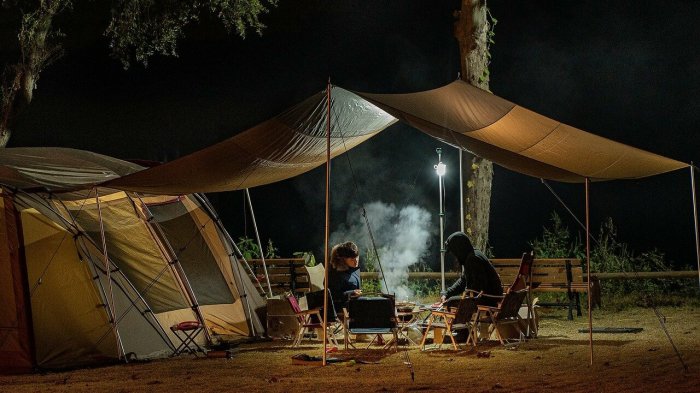
Source: utopia.org
Backyard camping offers a fantastic opportunity to enjoy the fun of camping without the hassle of traveling to a remote location. With a little creativity, you can transform your backyard into an exciting adventure zone for the whole family, offering a blend of daytime and nighttime activities that create lasting memories. The key is to plan engaging activities that cater to different ages and interests, ensuring everyone has a great time.
Here are five engaging activities perfect for a family backyard camping experience, ensuring both daytime and nighttime fun.
Five Engaging Backyard Camping Activities
- Daytime Nature Walk and Scavenger Hunt: Explore your backyard as if it were a wilderness area. Look for interesting insects, plants, or unique natural formations. Combine this with a scavenger hunt (detailed below) for an extra layer of excitement.
- DIY Campfire Crafts: Get creative with nature-inspired crafts. Use sticks, leaves, and pine cones to create miniature animals, fairy houses, or even nature collages. This is a great way to connect with nature and express creativity.
- Backyard Stargazing: As the sun sets, spread out blankets and enjoy stargazing. Download a stargazing app to identify constellations and planets. This offers a calming and educational experience.
- Campfire Stories and Storytelling: Gather around the campfire (or a safe alternative) and share spooky stories, funny anecdotes, or create collaborative tales. Encourage everyone to participate, making it a truly interactive experience.
- Glow-in-the-Dark Games: Extend the fun into the night with glow-in-the-dark games like capture the flag, frisbee, or even a simple game of hide-and-seek. The glow sticks add an extra layer of fun and excitement.
Creating a Camping-Themed Scavenger Hunt
A well-planned scavenger hunt adds a layer of adventure and excitement to your backyard camping experience. Start by creating a list of clues related to camping and your backyard. The clues should lead participants to different locations in the backyard, ultimately leading to a “treasure” – perhaps a small bag of treats or a fun camping-themed prize. Make the clues age-appropriate and challenging enough to keep everyone engaged but not frustrating.
Here are a few example clues:
- “I’m tall and strong, providing shade from the sun. Find me near the picnic table, the hunt has begun!” (Clue leads to a tree).
- “Where the birds sing their sweet melodies, you’ll find the next clue among the leaves, if you please.” (Clue leads to a bird feeder).
- “I’m a place for rest, where you lay your head. The next clue’s hidden beneath my comfy bed.” (Clue leads under a hammock or outdoor chair).
- “Near the water’s gentle flow, a shiny treasure you will find below.” (Clue leads to a small container near a water source – a birdbath or hose).
Making S’mores
S’mores are a classic camping treat, and making them is a fun activity for the whole family. You can easily adapt the recipe to suit different dietary needs.
| Ingredient | Quantity | Instructions | Notes |
|---|---|---|---|
| Graham Crackers | 6 (3 per s’more) | Use as the base and top of the s’more. | Choose gluten-free options for those with allergies. |
| Marshmallows | 6 large (2 per s’more) | Roast over a campfire or alternative heat source until golden brown and gooey. | Use vegan marshmallows for vegan diets. |
| Chocolate Bars | 3 (1 per s’more) | Break into smaller pieces for easier melting. | Use dairy-free chocolate for those with dairy sensitivities. |
Safety and Comfort: Tips For Camping In Your Backyard
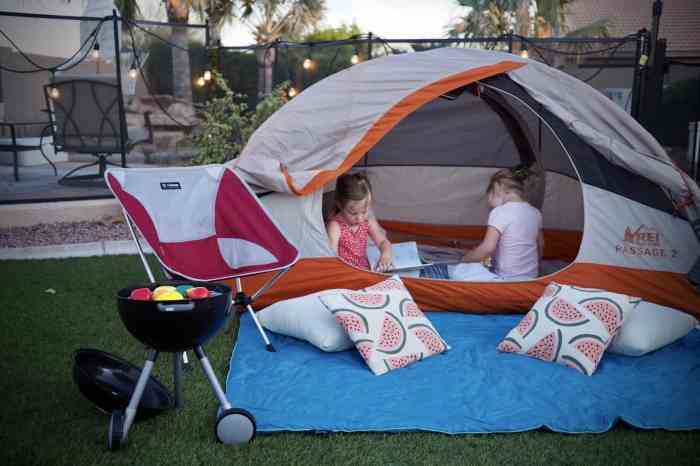
Source: territorysupply.com
Backyard camping, while seemingly low-risk, requires attention to safety and comfort to ensure a pleasant and worry-free experience. A little preparation goes a long way in preventing potential problems and maximizing your enjoyment. This section will cover some key aspects of ensuring your backyard camping adventure is both safe and relaxing.
Potential Safety Hazards and Preventative Measures
Several potential hazards can be present in even the most familiar backyard setting. It’s crucial to identify these and take steps to mitigate them before you even set up your tent.
- Tripping Hazards: Uneven ground, toys, garden tools, and tree roots can easily cause falls. Before setting up camp, thoroughly clear the area of any potential tripping hazards. Consider using a flashlight or headlamp to check for obstacles after dark.
- Fire Safety: Keep a safe distance between your campfire (if you have one) and any flammable materials such as trees, shrubs, or the house. Never leave a fire unattended, and have a bucket of water or sand nearby to extinguish it completely before bed.
- Wildlife Encounters: Depending on your location, you might encounter insects, rodents, or other small animals. Secure food and trash properly in airtight containers to avoid attracting unwanted guests. If you have pets, ensure they are safely contained for the night.
- Weather Conditions: Be prepared for sudden changes in weather. Have a plan in place if rain or strong winds occur, such as moving your sleeping arrangements indoors or under a covered area. Check the forecast before you begin.
Insect and Pest Management with Natural Repellents
Dealing with insects is a common camping concern, even in your own backyard. Fortunately, there are many safe and natural ways to deter pests.
- Citronella Candles or Torches: The scent of citronella is a well-known insect repellent. Place citronella candles or torches around your campsite to create a natural barrier against mosquitoes and other biting insects. However, ensure they are placed safely away from flammable materials.
- Essential Oils: Certain essential oils, such as lavender, lemongrass, and peppermint, are effective insect repellents. You can diffuse them using a diffuser or apply a few drops to your skin (diluted with a carrier oil like coconut oil). Always test a small area first for skin sensitivity.
- Physical Barriers: Use mosquito netting around your sleeping area to create a physical barrier against insects. This is particularly effective if you are sleeping outdoors or in a tent with mesh windows.
- Cleanliness: Keep your campsite clean and free of food scraps to minimize insect attraction. Dispose of trash properly in sealed containers.
Comparison of Camping Lights for Backyard Use
Choosing the right light source is essential for safety and comfort during your backyard camping adventure. Different types of lights offer various advantages and disadvantages.
- LED Lanterns: These are generally lightweight, portable, and energy-efficient, with long battery life. They offer a soft, diffused light, ideal for reading or general illumination. However, their brightness might be limited compared to other options. Example: A Coleman LED lantern can provide up to 100 hours of light on a single set of batteries.
- Headlamps: Headlamps offer hands-free illumination, perfect for navigating in the dark or performing tasks around the campsite. They are very portable but the brightness can vary greatly depending on the model and battery life can range from a few hours to several days. Example: A Black Diamond Spot 350 headlamp provides a powerful beam for navigating trails, but its battery life is shorter than a lantern’s.
- Solar Lights: Solar-powered lights are environmentally friendly and require no batteries. However, their brightness and reliability depend on sunlight availability. They are ideal for ambient lighting but might not be sufficient for tasks requiring focused light. Example: A string of solar-powered fairy lights might provide a charming atmosphere but won’t be bright enough for reading.
Food and Drinks
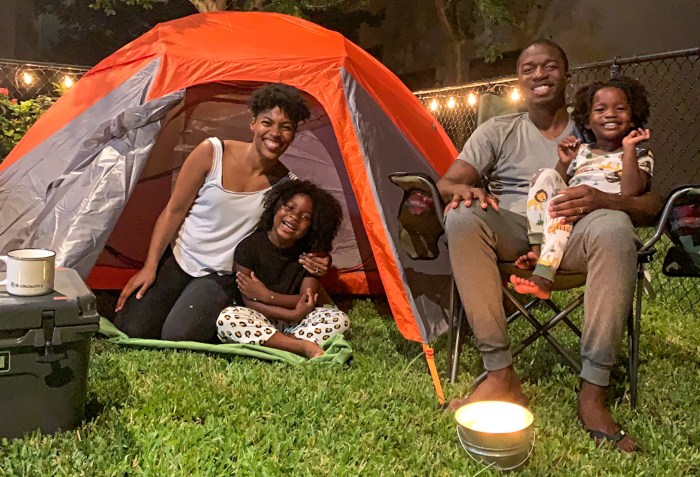
Source: thetravelingchild.co
Backyard camping doesn’t mean sacrificing delicious food! With a little planning, you can enjoy tasty meals and refreshing drinks without the fuss of a full-scale camping trip. The key is to choose recipes that are easy to prepare and require minimal cleanup, maximizing your relaxation time.Preparing food for your backyard camping adventure should focus on simplicity and ease of cooking.
Whether you’re using a campfire or a portable stove, choosing the right recipes will make the experience more enjoyable. Similarly, keeping drinks cool and accessible is essential for staying refreshed throughout your outdoor adventure.
Campfire or Stovetop Meals
Here’s a sample menu for a delicious and easy backyard camping meal. These recipes are adaptable to either a campfire or a portable stove.
- Campfire Foil Packets: Combine sliced potatoes, chopped onions, bell peppers, and your favorite protein (chicken sausage, steak, or even tofu) in foil packets. Season with herbs, salt, and pepper. Cook directly on the campfire coals or on a grill for about 20 minutes, flipping halfway through, until the vegetables are tender and the protein is cooked through. The foil contains all the juices and makes cleanup a breeze.
- One-Pot Campfire Chili: Brown ground beef or turkey in a heavy-bottomed pot over the campfire or stove. Add diced onions, garlic, canned diced tomatoes, kidney beans, and chili seasoning. Simmer for at least 30 minutes, stirring occasionally, until the chili has thickened. This hearty chili is perfect for a cool evening.
- Grilled Corn on the Cob: Soak corn on the cob in water for 30 minutes before grilling. Grill directly on the campfire coals, turning frequently, until the kernels are tender and slightly charred. Add butter, salt, and pepper to taste.
Refreshing Drinks, Tips for camping in your backyard
Staying hydrated is crucial, especially during warmer weather. Here are some refreshing drink options for your backyard camping trip.
- Water: The simplest and best option! Bring plenty of water in reusable bottles.
- Iced Tea: Brew a large batch of iced tea ahead of time and store it in a cooler. You can add lemon slices or other flavorings for extra refreshment.
- Lemonade: Homemade lemonade is a refreshing and easy option. You can prepare it in advance and keep it cool in a cooler.
- Fruit-Infused Water: Add sliced cucumbers, berries, or citrus fruits to a pitcher of water for a naturally flavored and hydrating drink.
To keep drinks cool without refrigeration, consider using a cooler with ice packs or freezing water bottles beforehand. Submerging your cooler in a larger container of water also helps maintain a cooler temperature.
Simple Camping Breakfast
A quick and easy breakfast is essential for a relaxed morning after your backyard camping adventure.
- Oatmeal with Berries and Nuts: Prepare quick-cooking oatmeal according to package directions using a portable stove or campfire. Top with fresh or frozen berries and a sprinkle of nuts for added protein and flavor. Minimal cleanup is involved.
This simple breakfast provides energy for the day and requires minimal dishes. You can also prepare this breakfast ahead of time by using overnight oats.
Wrap-Up
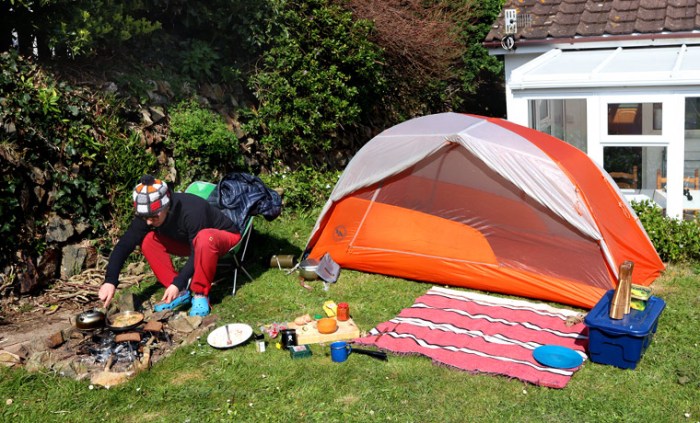
Source: coolofthewild.com
So, there you have it – a comprehensive guide to transforming your backyard into a thrilling camping destination. Remember, the key to a successful backyard campout is careful planning, a dash of creativity, and a whole lot of fun! Whether you’re a seasoned camper or a complete novice, this experience offers a unique blend of adventure and convenience.
Embrace the simplicity, enjoy the quality time with loved ones, and create memories that will last a lifetime. Now go forth and conquer your backyard wilderness!